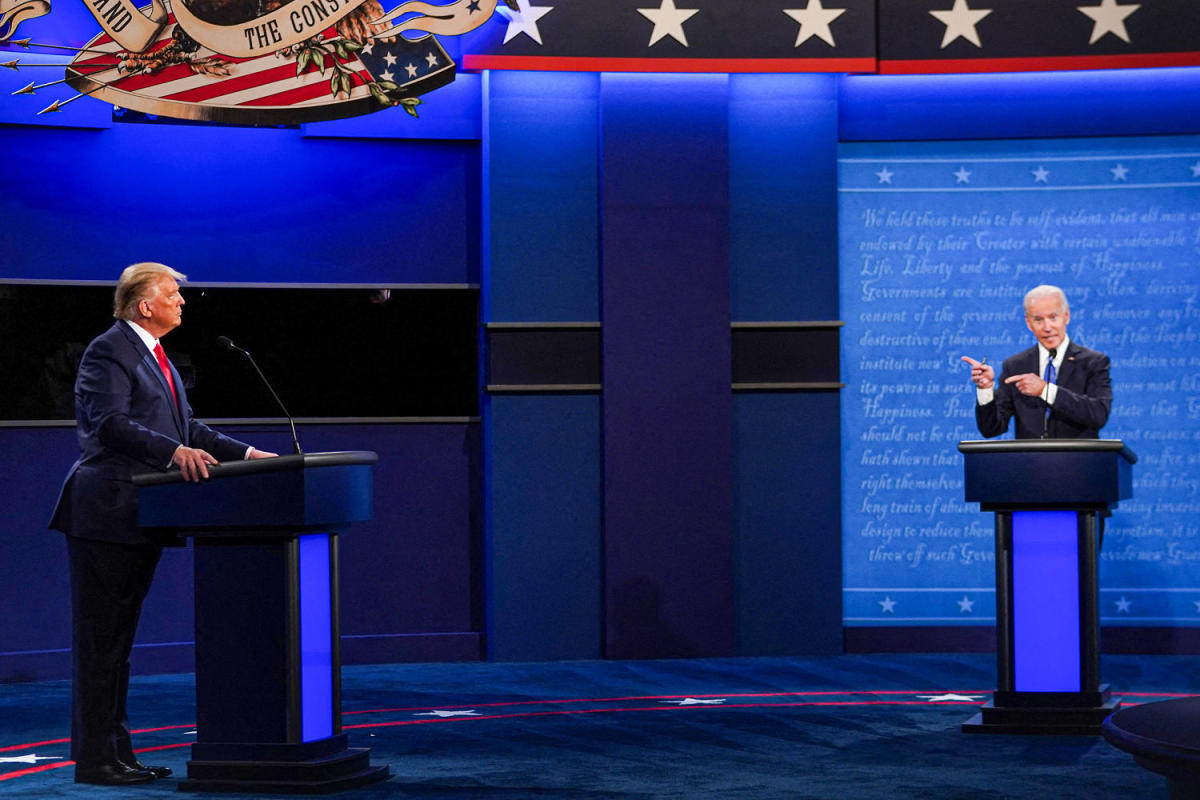On Tuesday night, Florida Atlantic fans left their cozy Boca Raton confines for a little Christmas in New York, proudly donning their red sweatshirts and T-shirts to cheer on the Owls at the Jimmy V Classic in Madison Square Garden. FAU earned an invite into the prestigious event by virtue of its Final Four run a year ago, not to mention its potential this year thanks to a mostly intact roster from that national semifinal appearance. At the Garden, the 11th-ranked Owls went toe-to-toe with Illinois, before bowing out 98-89. The loss does nothing to diminish Dusty May’s team, or its chance to match last season’s March run.
Charlie Baker’s plan, on the other hand? That could cut the Owls off at the knees. And Florida Atlantic is hardly alone. The school’s rise to the national rankings is just one of a collection of potential unintended consequences in the NCAA president’s pitch to create a new subdivision in college sports. Baker’s proposal, to create a group of schools that will operate under their own rules but in return will be obligated to pay at least half of their athletes $30,000 a year in some sort of a trust fund, has finally done away with the whole haves and have nots.
Welcome to the Have It Alls and Everyone Else.
“There are some things where there is a difference between what I would describe as the top hundred schools in terms of resources and the other 250,’’ Baker said at the Sports Business Journal Intercollegiate Athletic Forum. “And what happens is the NCAA ends up in one of these collisions that takes place because you have one-third of the schools who can do more for student-athletes. They just do. Once upon a time, the pursuit of competitive equity, that was considered to be OK. It’s not really anymore.’’
GO DEEPER
Commissioners react to Charlie Baker’s NCAA proposal on athlete compensation
There is no arguing that Baker is in a bind, and whatever you make of the plan, at least he has one. His predecessor Mark Emmert’s dithering/flat-out refusal to acknowledge that name, image and likeness was coming, put the NCAA in this predicament, forcing the national body to attempt to put up guardrails on the autobahn. This is Baker’s attempt to wrest some control of an NIL situation that has turned chaotic.
Well aware that the folks at the top of the food chain hold far more power and sway than the folks in Indianapolis do these days, Baker is trying to find an impossible middle ground in which he welcomes the progress necessary to keep the Have It Alls happy without entirely sacrificing Everyone Else. And for that matter, Everything Else college athletics has ever stood for.
This may be the only middle ground available, and the only way to ensure that the Have It Alls won’t take their balls, bats, epees, pucks and cleats elsewhere. It is miles away from completion, and collegiate insiders who spoke with The Athletic but asked not to be named as they parsed through the details themselves, thought it was as much a salvo to Congress as to the membership. A sort of, “Hey, we’re willing to do something, so can you help us out, please?” Baker, the former governor of Massachusetts, was tabbed the man for the job in no small part because he understood the machinations of Washington. He is doing his job, which no one ever accused Emmert of.
His letter, sent from all indications cold and without warning, was meant to be provocative and out of the box because he understands he needs to get people talking. This is a good thing. But as people start examining the proposal, they would be wise to also look really hard at the unintended consequences of such a broad action.
Because they are very real.
For argument’s sake, let’s take Baker’s proposal on merit and envision a world where some semblance of his pitch goes through the NCAA bureaucratic morass and passes. The schools in the cool kids’ club now have more governance authority and even rule-making power, so long as they agree to establish some sort of trust fund at $30,000 per year for half of their athletes. (But shh. Let’s not call that pay-to-play.)
So let’s consider that. It affects everybody, but for purposes of this exercise, let’s use FAU as an example. The school proudly proclaims on its website that, “with 19 NCAA Division I athletic teams, FAU strives to advance our nearly 500 student-athletes in their respective sports and the classroom.” Under Baker’s plan, half of those 500 athletes will get at least $30,000. That’s an additional $7.5 million annually, or $30 million over the life cycle of a four-year athlete. It also compounds, because not everyone graduates on time, so one year you might be carrying more than the average.
Per the school’s latest report to the NCAA, FAU brought in $39.2 million in revenues against $38.1 million in expenses. That doesn’t include long-term loan obligations used to fund things like stadium expansion that run a lifetime tab of $48 million, payable in chunks from now until 2041.
And now FAU would be on the hook for an additional $7.5 million a year — at minimum, because even Baker admitted the $30,000 is fungible. “That’s a permissive standard,’’ he said. “It’s a standard designed to establish the minimum.’’
Where is the extra money coming from, and better yet where is it going? Title IX will require that some of the funding goes to women’s sports, but it’s still going to feel like an episode of Oprah’s Favorite Things; only in this one, she skips every other audience member. Now you get a car. But not you. Fund this sport but not that one, or this athlete but not that one. The left tackle, not the right. The goalkeeper, not the striker.
Coaches have lamented that NIL would be the downfall of locker-room chemistry and honestly, it largely sounded ridiculous. Capitalism allows some people to make more than others. But it is one thing for an outside entity — or even a collective — to determine a player’s value; it is another altogether for a school and/or coach to assign a dollar figure athlete by athlete or sport by sport. (The school might have to tapdance around that, anyway, lest it look like it is directly paying athletes, which would make athletes employees.)
Let’s face it. At the power-conference level and the Group of 5, which still has a shot at the Wonka-esque golden ticket to the College Football Playoff, football needs to be fed. Operating at the trust fund NIL minimum wage simply won’t cut it. If the gymnast gets $30,000, find some more zeroes for the quarterback.
By default, that means there will be less money for other sports. Even including basketball.
Programs such as FAU, the ones that serve as the lifeblood of the NCAA Tournament, grow organically. May has spent five years with the Owls, finding underrecruited players (Johnell Davis and Alijah Martin) and partnering them with transfers in need of a reboot (Vladislav Goldin) before turning the Owls into March magic. Come to think of it, that’s how Jay Wright built a Hall of Fame career.
It is not to say such a rise can’t and won’t happen with a new subdivision; it’s just going to be that much more difficult. The transfer portal already makes roster stability hard enough, in basketball and football alike. Adding the promise of a $120,000 trust fund in one place but not another will make it all the more difficult.
But perhaps the greatest loss will come where no one ever looks — at the Olympic sport level. Until around 2001, Division I sport team numbers grew fairly regularly — around 2 to 4 percent more teams added per year. Since then, the number of teams added has hovered below 1 percent and, per NCAA data, in the last two years has fallen into the negative (-0.93 in 2021, -0.33 in 2022). Blame COVID-19, no doubt. After the pandemic, 35 Division I schools cut more than 110 programs, according to the Business of College Sports. Loss of revenue combined with the rise of NIL simply made their existence unsustainable.
This will not help. The easiest way to establish a fund for half of your athletes to get $30,000 is to have fewer athletes, and no one is cutting a moneymaker.
If that sounds apocalyptic, well, the apocalypse is here. Do remember: Stanford threatened to cut 11 sports, reversing course only after public outcry. Stanford has a lot of money. Most schools do not.
Then again, this is not about most schools. This is the core of the problem. Baker is doing what he can to find a solution, but he is trying to salvage an incredibly broken system. College athletics continues to dance on the head of a pin for a handful of schools who already have been given almost everything they’ve asked for — including, do recall, some sense of NCAA autonomy. And it always comes at the expense of everyone else. As one administrator put it: “If you’re not in, are you somehow less than? Does your brand take a hit? Is it diminished?”
The answer, of course, is yes.
(Photo of Florida Atlantic’s Alijah Martin at Tuesday’s Jimmy V Classic: Rich Schultz / Getty Images)

Daniel Miller is a sports fanatic who lives and breathes athletics. His coverage spans from major league championships to local sports events, delivering up-to-the-minute updates and in-depth analysis for sports enthusiasts.







/cdn.vox-cdn.com/uploads/chorus_asset/file/25449825/65cf71ee2368ff61aaf13de7_1.jpg)